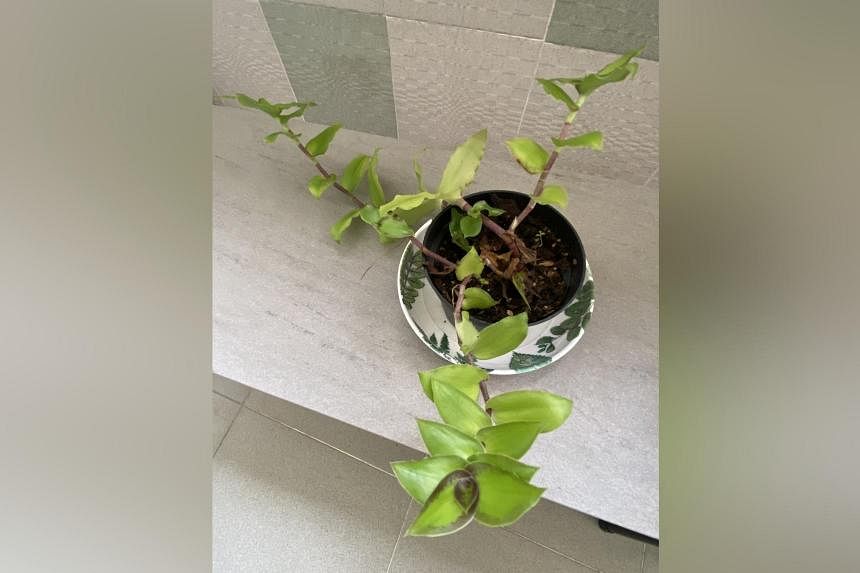Dragon Tail thrives under filtered sunlight
Is this plant a ground creeper? How do I care for and propagate it?
Alan Tok
The Dragon Tail (botanical name: Callisia soconuscensis) produces trailing, fleshy stems with a somewhat flat rosette of leaves at the tips.
It is easily propagated via stem cuttings – place a cutting in a moist pot of growing media in a shady area or let it root in water before planting in a container. This plant thrives in a site with filtered sunlight.
Sawtooth Coriander, Holy Basil are common herbs
What are these plants and are they edible? The first one is next to a soursop plant. Is the second a Holy Basil plant?
Lih Shyan
The first herb is the Sawtooth Coriander (botanical name: Eryngium foetidum), which can be grown under direct or filtered sunlight with a moist substrate. It emits a strong scent similar to that of coriander, but is easier to grow in Singapore’s climate and can be used sparingly in dishes that call for the herb.
The second plant is the Holy Basil (botanical name: Ocimum tenuiflorum). It is both a culinary and medicinal herb. A cultivar with purple leaves can sometimes be found in Singapore. It grows best in a site that gets direct sunlight and with well-draining soil.
Large-Flower Kleinia may be lacking in nutrients
My plant’s new leaves are smaller and less green than when it was brought home. I water it daily and have placed it in a spot with full sunlight. I am told the leaves have medicinal properties. What is this plant and how do I care for it?
Phemie Kiong
The Large-Flower Kleinia (botanical name: Kleinia grandiflora) is a herb used in Ayurvedic medicine with anti-inflammatory properties.
In this picture, the lower leaves look yellow. This could be due to a deficiency in nutrients such as nitrogen. Also, the plant may have dried out or developed wet feet.
Has the plant been growing in the same container for a long time with no fertiliser? If it is growing in organic material-based media like cocopeat, it could have broken down and exhausted the medium’s nutrients. Move the plant to a new pot with a fresh growing mix.
If the plant has not been fed for a long time, it may have starved. Use organic or chemical fertiliser pellets to feed your plant, but not so much that you burn it.
Though this species is drought-tolerant, do not let it dry out completely. If the growing mix has broken down, it may also be retaining too much water.
Either way, the roots will be damaged and the plant will not be able to take up nutrients. Water it regularly and make sure the root zone has dried out slightly between sessions.
Plant roots infested with mealybugs
When I bought this plant, there was white matter on it. As my plant grew, I moved it to a transparent container and watered it weekly. It stopped growing new leaves after a while and I saw white specks in the growing mix. I washed them off, and treated the plant and repotted it. But the white specks returned as new leaves grew. How do I get rid of the pests?
Sharon Yap
The white masses appear to be sap-sucking pests – most likely root mealybugs, which spread easily via water trickling from infested plant pots, or a growing mix containing eggs or live adults.
If this plant is being grown for ornamental purposes, you can use systemic pesticide pellets such as those containing dinotefuran, which will introduce the pesticide into the plant’s sap. This will kill the pests when they ingest it.
Jambu suffering from nutrient deficiency; check for pests
I repotted my jambu plant, but it is not fruiting. Does it need more fertiliser? Also, has it split into two plants and will this damage the roots?
Ng Shuling
Your jambu needs to be grown in a spot that gets at least six hours of direct sunlight daily.
The bite marks on the leaves could be due to chewing pests such as beetles. Monitor the plant for their presence and take appropriate action. You may need to apply chemical pesticides to manage the issue.
Fertilise your plant regularly. Its pot looks small, so move it to one that is twice the diameter of the current container. Ensure the growing mix is well-draining and aerated, and slightly acidic, for healthy roots.
Answers by Dr Wilson Wong, an NParks-certified practising horticulturist and parks manager. He is the founder of Green Culture Singapore and an adjunct assistant professor (Food Science & Technology) at the National University of Singapore.
Have a gardening query? E-mail it with clear, high-resolution pictures of at least 1MB, if any, and your full name to stlife@sph.com.sg. We reserve the right to edit and reject questions.
Root Awakening: Lady’s Finger’s leaves change shape with age
Root Awakening: Pencil Cactus flowers are easily missed
Join ST’s Telegram channel and get the latest breaking news delivered to you.
p.st_telegram_boilerplate:before {
display: inline-block;
content: ” “;
border-radius: 6px;
height: 6px;
width: 6px;
background-color: #12239a;
margin-left: 0px;
margin-right: 13px;
}
a.st_boilerplate {
font-family: “SelaneWebSTForty”, Georgia, “Times New Roman”, Times, serif;
}


